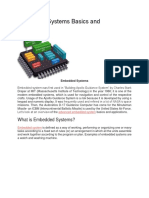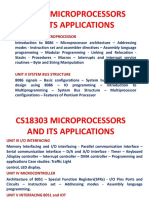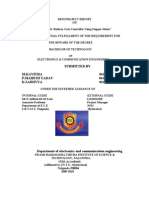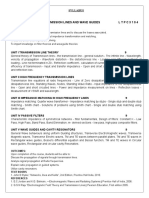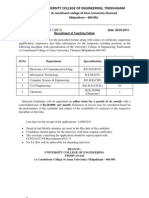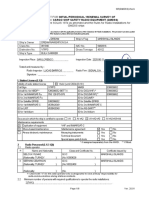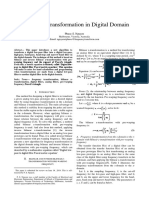0 ratings0% found this document useful (0 votes)
175 viewsEmbedded System
Embedded System
Uploaded by
dheep_infotel3985This document provides an overview of embedded systems, including their history, categories, architecture, characteristics, trends, and application areas. It discusses how embedded systems combine computer hardware and software for specific applications. Examples of early embedded systems include the Apollo guidance computer and Minuteman missile computer. Common embedded system components are processors, memory, and input/output devices. Software typically includes device drivers, an operating system, and application programs. Embedded systems are used in a wide range of applications such as automotive, medical, consumer electronics, and industrial control systems.
Copyright:
© All Rights Reserved
Available Formats
Download as PPT, PDF, TXT or read online from Scribd
Embedded System
Embedded System
Uploaded by
dheep_infotel39850 ratings0% found this document useful (0 votes)
175 views16 pagesThis document provides an overview of embedded systems, including their history, categories, architecture, characteristics, trends, and application areas. It discusses how embedded systems combine computer hardware and software for specific applications. Examples of early embedded systems include the Apollo guidance computer and Minuteman missile computer. Common embedded system components are processors, memory, and input/output devices. Software typically includes device drivers, an operating system, and application programs. Embedded systems are used in a wide range of applications such as automotive, medical, consumer electronics, and industrial control systems.
Original Description:
Embedded system
Original Title
Embedded system
Copyright
© © All Rights Reserved
Available Formats
PPT, PDF, TXT or read online from Scribd
Share this document
Did you find this document useful?
Is this content inappropriate?
This document provides an overview of embedded systems, including their history, categories, architecture, characteristics, trends, and application areas. It discusses how embedded systems combine computer hardware and software for specific applications. Examples of early embedded systems include the Apollo guidance computer and Minuteman missile computer. Common embedded system components are processors, memory, and input/output devices. Software typically includes device drivers, an operating system, and application programs. Embedded systems are used in a wide range of applications such as automotive, medical, consumer electronics, and industrial control systems.
Copyright:
© All Rights Reserved
Available Formats
Download as PPT, PDF, TXT or read online from Scribd
Download as ppt, pdf, or txt
0 ratings0% found this document useful (0 votes)
175 views16 pagesEmbedded System
Embedded System
Uploaded by
dheep_infotel3985This document provides an overview of embedded systems, including their history, categories, architecture, characteristics, trends, and application areas. It discusses how embedded systems combine computer hardware and software for specific applications. Examples of early embedded systems include the Apollo guidance computer and Minuteman missile computer. Common embedded system components are processors, memory, and input/output devices. Software typically includes device drivers, an operating system, and application programs. Embedded systems are used in a wide range of applications such as automotive, medical, consumer electronics, and industrial control systems.
Copyright:
© All Rights Reserved
Available Formats
Download as PPT, PDF, TXT or read online from Scribd
Download as ppt, pdf, or txt
You are on page 1of 16
CONTENT
INTRODUCTION TO EMBEDDED SYSTEM
HISTORY
CATEGORIES OF EMBEDDED SYSTEM
OVERVIEW OF EMBEDDED SYSTEM ARCHITECTURE
CHARACTERISTICS
SPECIALITIES OF EMBEDDED SYSTEMS
RECENT TRENDS IN EMBEDDED SYSTEMS
APPLICATION AREAS
CONCLUSION
REFERENCES
INTRODUCTION TO EMBEDDED
SYSTEM
What is an Embedded System
An embedded system is some combination of computer hardware & software,
either fixed in capability or programmable, that is specifically designed for a
particular kind of application device
Embedded System Design : H/W +S/W
Application Software
OS (porting or design)
Device Driver
Hardware (target platform)
HISTORY
One of the first recognizably modern embedded systems was the Apollo
Guidance Computer, developed by Charles Stark Draper at the MIT
Instrumentation Laboratory
An early mass-produced embedded system was the Autonetics D-17 guidance
computer for the Minuteman missile, released in 1961
Since these early applications in the 1960s, embedded systems have come down
in price and there has been a dramatic rise in processing power and functionality.
The first microprocessor for example, the Intel 4004, was designed for
calculators and other small systems but still required many external memory and
support chips. In 1978 National Engineering Manufacturers Association released
a "standard" for programmable microcontrollers, including almost any computer-
based controllers, such as single board computers, numerical, and event-based
controllers.
CATEGORIES OF EMBEDDED
SYSTEM
Stand-alone Embedded Systems
Real-time Systems
Network Information Appliances
OVERVIEW OF EMBEDDED SYSTEM
ARCHITECTURE
BUILDING BLOCK OF HARDWARE
OF AN EMBEDDED SYSTEM
Central Processing Unit (CPU)
Memory
Input devices
Output devices
SOFTWARE IN EMBEDDED SYSTEM
Software : Device driver + OS + Application program
Device driver
Digital IO (GPIO-LED, Relay, Switch,) , ADC, DAC, U(S)ART,
Timer/counter, WDT, I2C, SPI, PWM, Actuator, Sensor, Touch screen, IRDA,
Network (Ethernet, X.25, Wireless...), USB, IEEE1394 (Firewire), Audio,
Video Graphic, LCD, Keyboard, Mouse, DMAC, Bluetooth
OS or non-OS
OS roles and missions
Process Management : Task scheduling, Context switching
Resource Management : CPU, MMU, Disk, I/O devices
File System : FAT, NTFS, EXT2/3, JFS, NFS
Device Driver : I/O, Network
GUI, Security, ...
Embedded system OS
Multi-tasking, Network, Multimedia, Portable, Preemptive, Deterministic
(Hard Real-time), Robust & Reliable
CHARACTERISTICS
Embedded systems are designed to do some specific task,
rather than be a general-purpose computer for multiple
tasks. Some also have real-time performance constraints
that must be met, for reasons such as safety and usability;
others may have low or no performance requirements,
allowing the system hardware to be simplified to reduce
costs.
User interface
Processors in embedded systems
Ready made computer boards
Peripherals
Tools
Debugging
Reliability
User interface
SPECIALITIES OF EMBEDDED
SYSTEMS
Performance
Power Consumption
Cost
Size
Software Up gradation capability
RECENT TRENDS IN EMBEDDED
SYSTEMS
Processor Power
Mobile Devices
Operating Systems
Communication Interfaces and Networking Capability
Programming Languages
Automative
Ignition System
Engine Control
Brake System
Medical
Infusion Pumps
Dialysis Machine
Prosthetic Device
Cardiac Monitor
Networking
Router
Hubs
Gateways
Consumer Electronic
TV
Set-Top Box
PDA
Kitchen Application
Toys/Games
Telephone/Cell Phones
Camera/GPS
Industrial Contol
Robotics
Control System
Art.Satellies
Missiles
Nuclear Reactors
Space Stations
Shuttles
Office Automation
Fax
Copier
Printers
Scanners
Card Readers
Monitors
APPLICATION AREAS
CONCLUSION
Thus embedded systems contain programmed instruction running via
processor chips. They perform control, protection & monitoring tasks. In
broad terms embedded systems are programmable devices or systems
which are generally used to control or monitor things like processes
machi ner y, envi r onment al equi pment & communi cat i ons .
REFERENCES
Embedded Systems Architecture, Designing and Programming By Rajkamal.
Embedded Systems Programming and Designing By Michael Barr.
Designing Of Embedded Hardware By John Keysoukisi.
Embedded System Design By Frank Vahid.
www.embedded.com www.nptel.iitm.ac.in
Create
Knowledge
Structure
Knowledge
Disseminate
Knowledge
Apply
Knowledge
Assimilate
Knowledge
Seminar -
Knowledge
Sharing
And
Acquiring
Environment
Apply
Knowledge
Assimilate
Knowledge
Disseminate
Knowledge
Apply
Knowledge
Assimilate
Knowledge
Structure
Knowledge
Disseminate
Knowledge
Apply
Knowledge
Assimilate
Knowledge
You might also like
- Electrical Equivalent Circuit Modeling of Lithium Ion BatteryDocument5 pagesElectrical Equivalent Circuit Modeling of Lithium Ion BatteryMrinal SarvagyaNo ratings yet
- 32-Bit Arm Cortex-M3 Lpc1768 Microcontroller Block DiagramDocument3 pages32-Bit Arm Cortex-M3 Lpc1768 Microcontroller Block Diagramsiva kumaar100% (1)
- Embedded Systems Basics and ApplicationsDocument27 pagesEmbedded Systems Basics and ApplicationsPriyanka PalsaniyaNo ratings yet
- By: Muhammad Huzafa Reg.#: EE172081Document27 pagesBy: Muhammad Huzafa Reg.#: EE172081HuzafaNo ratings yet
- Presentation On AsicsDocument20 pagesPresentation On AsicsShruti ChaudharyNo ratings yet
- Presented by C.Gokul, Ap/Eee: Departments: Cse, It, Ece, Ece, Mech Regulation: 2013Document633 pagesPresented by C.Gokul, Ap/Eee: Departments: Cse, It, Ece, Ece, Mech Regulation: 2013SATHEESHNo ratings yet
- MPMCDocument677 pagesMPMCBeardNo ratings yet
- Comparison of MicrocontrollerDocument5 pagesComparison of MicrocontrollerGitesh MisalNo ratings yet
- A Battery Management System Using An Active Charge Equalization Technique Based On A DC/DC Converter TopologyDocument8 pagesA Battery Management System Using An Active Charge Equalization Technique Based On A DC/DC Converter TopologyNyk MunNo ratings yet
- Vtu Lab Manuals VlsiDocument79 pagesVtu Lab Manuals VlsisrikanthuasNo ratings yet
- Embedded System in VehiclesDocument16 pagesEmbedded System in VehiclesNida QureshiNo ratings yet
- DCP NotesDocument201 pagesDCP NotesSiva Kumar100% (1)
- Ee6008 - Microcontroller Based System DesignDocument91 pagesEe6008 - Microcontroller Based System DesignAthithyaNo ratings yet
- Components For Embedded ProgramsDocument16 pagesComponents For Embedded ProgramsRajesh cNo ratings yet
- What Is A Microcontroller?: MicrocontrollersDocument16 pagesWhat Is A Microcontroller?: MicrocontrollersJeanNo ratings yet
- Project Report On Robotic ArmDocument17 pagesProject Report On Robotic ArmGina SreeNo ratings yet
- 2... Vijay-Advanced Security Systems in Jewellery Shops and Banks PDFDocument97 pages2... Vijay-Advanced Security Systems in Jewellery Shops and Banks PDFShanker PandeyNo ratings yet
- Applications of Embedded Systems-Yashwanth-R20ek038Document14 pagesApplications of Embedded Systems-Yashwanth-R20ek038Yash V100% (1)
- RF Based Automatic Speed Limiter For VehiclesDocument35 pagesRF Based Automatic Speed Limiter For Vehiclesv3rajasekarNo ratings yet
- Stepper Motor Positioning Control by IR RemoteDocument80 pagesStepper Motor Positioning Control by IR RemotesathishNo ratings yet
- Study WellDocument2 pagesStudy WellpsmeeeNo ratings yet
- Automatic Railway Gate Controller DocumentationDocument53 pagesAutomatic Railway Gate Controller Documentationmnair201167% (3)
- 18mca54e U5Document16 pages18mca54e U5priyaNo ratings yet
- PicDocument23 pagesPicParamdeep Singh Bhatia100% (1)
- IOT Vs M2MDocument12 pagesIOT Vs M2MHarini IyerNo ratings yet
- EE4S23 - ASIC Technology and Test SystemsDocument39 pagesEE4S23 - ASIC Technology and Test Systemsfahadmas872070No ratings yet
- Term Paper On Embedded SystemDocument11 pagesTerm Paper On Embedded Systemsupreetsingh1960% (1)
- Embedded System Lab Manual: B.Tech (Cse) Vi SemesterDocument56 pagesEmbedded System Lab Manual: B.Tech (Cse) Vi Semesterjesudosss0% (1)
- MPMC Lab ManualDocument157 pagesMPMC Lab ManualSanmuga SundaramNo ratings yet
- Ec3551 TLRF Unit-2 QBDocument3 pagesEc3551 TLRF Unit-2 QBkaviyaNo ratings yet
- CLPDDocument2 pagesCLPDSivaMarojuNo ratings yet
- Tms 320 F 28379 DDocument222 pagesTms 320 F 28379 DJuan Ku LosanoNo ratings yet
- Asynchronous ChipsDocument25 pagesAsynchronous ChipsAbin Varkey Varghese100% (1)
- Eee IV Field Theory (10ee44) NotesDocument194 pagesEee IV Field Theory (10ee44) Notesಶ್ರೀಕಾಂತ್ ತಿಪ್ಪೇರುದ್ರಪ್ಪNo ratings yet
- DC Motor Speed C BcontrolDocument6 pagesDC Motor Speed C BcontrolRoger RozarioNo ratings yet
- Unit-4 PPT. Embedded Systems by SuryaDocument34 pagesUnit-4 PPT. Embedded Systems by SuryaAnonymous 3yqNzCxtTz100% (1)
- CS3351 Digital Principles and Computer Organization Nov Dec 2022 Question Paper DownloadDocument3 pagesCS3351 Digital Principles and Computer Organization Nov Dec 2022 Question Paper Downloadkanimozhi rajasekarenNo ratings yet
- Mini Project ReportDocument15 pagesMini Project ReportShirsendu AcharyyaNo ratings yet
- Syllabus Ec6503-Transmission Lines and Wave GuidesDocument1 pageSyllabus Ec6503-Transmission Lines and Wave GuidesSurendhar SNo ratings yet
- 9 - ES - Hardware Software Co-DesignDocument55 pages9 - ES - Hardware Software Co-DesignSaket GoluNo ratings yet
- 8051 IntroDocument18 pages8051 Introusha narayanNo ratings yet
- 186 - EC6703 Embedded and Real Time Systems - 2 Marks With AnswersDocument24 pages186 - EC6703 Embedded and Real Time Systems - 2 Marks With AnswersRiya RaiNo ratings yet
- EI 8075 Fibre Optics and Laser Instruments Industrial Application of Fiber Optical SensorDocument21 pagesEI 8075 Fibre Optics and Laser Instruments Industrial Application of Fiber Optical Sensorsyed1188100% (1)
- IT1353 Embedded System (All 5 Units)Document71 pagesIT1353 Embedded System (All 5 Units)Dr. N.ShanmugasundaramNo ratings yet
- Electric Vehicle 2nd ModuleDocument22 pagesElectric Vehicle 2nd ModuleAmruth DeshpandeNo ratings yet
- Analog VLSI Design: Technology TrendsDocument31 pagesAnalog VLSI Design: Technology TrendsSathyaNarasimmanTiagarajNo ratings yet
- Battery Management SystemDocument21 pagesBattery Management SystemAbdullah100% (1)
- IOT Project Report: Solar Panel Monitoring SystemDocument13 pagesIOT Project Report: Solar Panel Monitoring SystemAnushka ShahNo ratings yet
- CA5305.Lecture 5 Internet of Things Reference Model: Instructor: Dr. M. DeivamaniDocument27 pagesCA5305.Lecture 5 Internet of Things Reference Model: Instructor: Dr. M. DeivamaniHarini Iyer100% (1)
- Serial CommunicationDocument52 pagesSerial CommunicationDr Narayana Swamy RamaiahNo ratings yet
- Remotely Controlled Android Based Electronic Notice BoardDocument27 pagesRemotely Controlled Android Based Electronic Notice BoardyasirNo ratings yet
- Microcontrollers and Its ApplicationDocument55 pagesMicrocontrollers and Its ApplicationKabilesh Gopalakrishnan100% (1)
- Automatic Temperature & Brightness ControllerDocument67 pagesAutomatic Temperature & Brightness ControlleryrikkiNo ratings yet
- Microprocessor - Overview: How Does A Microprocessor Work?Document8 pagesMicroprocessor - Overview: How Does A Microprocessor Work?vedavyas99No ratings yet
- Lab Manual CS7001 Distributed System Powered by A2softech (A2kash)Document30 pagesLab Manual CS7001 Distributed System Powered by A2softech (A2kash)Aakash Kumar PawarNo ratings yet
- Green Communications: Principles, Concepts and PracticeFrom EverandGreen Communications: Principles, Concepts and PracticeKonstantinos SamdanisNo ratings yet
- Embedded System Programming: Manasvi Mehta BCA-16 Roll No.-0800818093 UPTEC Computer Consultancy AllahabadDocument16 pagesEmbedded System Programming: Manasvi Mehta BCA-16 Roll No.-0800818093 UPTEC Computer Consultancy AllahabadManasvi MehtaNo ratings yet
- Finger Print Based Electronic Voting MachineDocument88 pagesFinger Print Based Electronic Voting MachineShakir Rahmani100% (1)
- MainProj Matrl Givn by SirDocument8 pagesMainProj Matrl Givn by Sirlucky jNo ratings yet
- Embedded SystemDocument19 pagesEmbedded SystemMohd SohailNo ratings yet
- University: Syllabus S. No Sub Code Subject Title L T P MDocument1 pageUniversity: Syllabus S. No Sub Code Subject Title L T P Mdheep_infotel3985No ratings yet
- Operational Amplifiers: Kristin Ackerson, Virginia Tech Ee Spring 2002 - Vtech - Calvin Project For Prof. RibeiroDocument29 pagesOperational Amplifiers: Kristin Ackerson, Virginia Tech Ee Spring 2002 - Vtech - Calvin Project For Prof. Ribeirodheep_infotel3985100% (2)
- DC Machines: Version 2 EE IIT, KharagpurDocument14 pagesDC Machines: Version 2 EE IIT, Kharagpurdheep_infotel3985No ratings yet
- Ee1251 Electrical Machines IIDocument16 pagesEe1251 Electrical Machines IIdheep_infotel3985No ratings yet
- Improving Network Connectivity in Ad Hoc Networks Using Particle Swarm Optimization and AgentsDocument21 pagesImproving Network Connectivity in Ad Hoc Networks Using Particle Swarm Optimization and Agentsdheep_infotel3985No ratings yet
- DC Generator: - An Electric Generator Is A Device That Converts ToDocument6 pagesDC Generator: - An Electric Generator Is A Device That Converts Todheep_infotel3985No ratings yet
- GMDSS FrequenciesDocument8 pagesGMDSS Frequenciesdheep_infotel3985No ratings yet
- Status Qualification JOB Place Contact Reg - No Name Gothram StarDocument29 pagesStatus Qualification JOB Place Contact Reg - No Name Gothram Stardheep_infotel3985No ratings yet
- University College of Engineering, Tindivanam: UCET/TF/Recruitment-1/2013Document2 pagesUniversity College of Engineering, Tindivanam: UCET/TF/Recruitment-1/2013dheep_infotel3985No ratings yet
- E300 Electronic Overload Relay User Manual - Reconocimiento de FallasDocument6 pagesE300 Electronic Overload Relay User Manual - Reconocimiento de FallasDiegoTecTruxNo ratings yet
- TM 11-6665-209-40 - Radiac - Set - AN - PDR-27 - 1981Document45 pagesTM 11-6665-209-40 - Radiac - Set - AN - PDR-27 - 1981Wurzel1946No ratings yet
- Cross Layer Method of Reliable Transmission in UAV Ad Hoc Network Based On Improved Ant Colony AlgorithmDocument13 pagesCross Layer Method of Reliable Transmission in UAV Ad Hoc Network Based On Improved Ant Colony AlgorithmnorthwestuniversityrucerNo ratings yet
- BD9882F, FVDocument5 pagesBD9882F, FVbahti1284No ratings yet
- Under Monitor Display SystemsDocument7 pagesUnder Monitor Display SystemsLaurentiu IacobNo ratings yet
- Direct Torque Control For Induction Motors Based On Minimum Voltage Vector ErrorDocument11 pagesDirect Torque Control For Induction Motors Based On Minimum Voltage Vector ErrorSONU KUMARNo ratings yet
- Urmet Catalogue EN Web PDFDocument238 pagesUrmet Catalogue EN Web PDFAlvinNo ratings yet
- Duracell Charger Instructions CEF14NA4 ENDocument1 pageDuracell Charger Instructions CEF14NA4 ENZeeshan AhmadNo ratings yet
- SB Solar BatteryDocument2 pagesSB Solar BatteryJGAR2009No ratings yet
- Treadmill 93t.serviceDocument202 pagesTreadmill 93t.servicepowerliftermilo100% (1)
- GVAN11Document2 pagesGVAN11lucas_guerrero2No ratings yet
- Introduction To Flash Memory: Proceedings of The IEEE May 2003Document15 pagesIntroduction To Flash Memory: Proceedings of The IEEE May 2003joe angelo bascoNo ratings yet
- SR - Gmdss Check PDFDocument8 pagesSR - Gmdss Check PDFlucas barriosNo ratings yet
- DFT Notes PrepDocument13 pagesDFT Notes PrepBrijesh S D100% (3)
- Standard Microcircuit Drawing: Microcircuit, Linear, High Speed Differential Line Driver, Monolithic SiliconDocument15 pagesStandard Microcircuit Drawing: Microcircuit, Linear, High Speed Differential Line Driver, Monolithic SiliconmandameloaNo ratings yet
- EVM4Document5 pagesEVM4PriyantanuNo ratings yet
- CLP 1771 Allen BradleyDocument253 pagesCLP 1771 Allen Bradleyjuliano diasNo ratings yet
- Tikona Digital Networks Launches Its Operations in SuratDocument2 pagesTikona Digital Networks Launches Its Operations in SuratChirag JesadiyaNo ratings yet
- Frequency Transformation in Digital DomainDocument5 pagesFrequency Transformation in Digital DomainNguyen Si PhuocNo ratings yet
- Principle of MOSFET Device TechnologyDocument3 pagesPrinciple of MOSFET Device TechnologyCHING HUI YEENo ratings yet
- Speed Log 4642Document4 pagesSpeed Log 4642John PerdyNo ratings yet
- Multi-Function Power Meter - A2000Document8 pagesMulti-Function Power Meter - A2000C&P GroupNo ratings yet
- Trail Blazer P06A3Document8 pagesTrail Blazer P06A3Miguel Ángel Martínez AlfonsoNo ratings yet
- SIP Trunking Configuration Guide For Cisco Unified C Ommunications Manager 10.5.1.10000-7 (CUCM) Version With Cisco Unified Border Element (CUBE)Document61 pagesSIP Trunking Configuration Guide For Cisco Unified C Ommunications Manager 10.5.1.10000-7 (CUCM) Version With Cisco Unified Border Element (CUBE)drineNo ratings yet
- 2 T 6 WBX CKDocument16 pages2 T 6 WBX CKolangomark100% (1)
- How To Make Your Own ZAPPERDocument14 pagesHow To Make Your Own ZAPPERaccime24100% (4)
- Digital Clock CircuitDocument8 pagesDigital Clock CircuitPrabuddha ChakrabortyNo ratings yet
- EDCM2Document19 pagesEDCM2yanith kumarNo ratings yet
- User Guide. NCR X-Series Displays (5968 - 5985) B Issue BDocument62 pagesUser Guide. NCR X-Series Displays (5968 - 5985) B Issue Bdukindonutz123No ratings yet
- C Ac101:It Fundamentals-I: Session 2021-22 Page:1/1Document1 pageC Ac101:It Fundamentals-I: Session 2021-22 Page:1/1HariNo ratings yet


